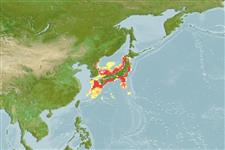Teleostei (teleosts) >
Gadiformes (Cods) >
Moridae (Morid cods)
Etymology: Physiculus: Diminutive of Greek, physa = tube.
More on author: Hilgendorf.
Environment: milieu / climate zone / depth range / distribution range
Ecology
Marine; bathydemersal; depth range 139 - 1007 m (Ref. 27311). Deep-water; 43°N - 24°N, 125°E - 144°E (Ref. 1371)
Northwest Pacific: Japan and the East China Sea.
Size / Weight / Age
Maturity: Lm ? range ? - ? cm
Max length : 35.0 cm TL male/unsexed; (Ref. 1371)
Dorsal spines (total): 0; Anal spines: 0. Ventral light organ well behind a line between pelvic fins. Color is light brown to pinkish tan on dorsal portions, grading to blue-black ventrally.
Found on rough, rocky bottom along the continental shelf and upper slope (Ref. 1371).
Life cycle and mating behavior
Maturity | Reproduction | Spawning | Eggs | Fecundity | Larvae
Cohen, D.M., T. Inada, T. Iwamoto and N. Scialabba, 1990. FAO species catalogue. Vol. 10. Gadiform fishes of the world (Order Gadiformes). An annotated and illustrated catalogue of cods, hakes, grenadiers and other gadiform fishes known to date. FAO Fish. Synop. 125(10). Rome: FAO. 442 p. (Ref. 1371)
IUCN Red List Status (Ref. 130435: Version 2024-2)
Threat to humans
Harmless
Human uses
Fisheries: subsistence fisheries
Tools
Special reports
Download XML
Internet sources
Estimates based on models
Preferred temperature (Ref.
123201): 0.6 - 13.7, mean 6.4 °C (based on 53 cells).
Phylogenetic diversity index (Ref.
82804): PD
50 = 0.5000 [Uniqueness, from 0.5 = low to 2.0 = high].
Bayesian length-weight: a=0.00389 (0.00192 - 0.00787), b=3.11 (2.93 - 3.29), in cm total length, based on LWR estimates for this (Sub)family-body shape (Ref.
93245).
Trophic level (Ref.
69278): 4.2 ±0.4 se; based on diet studies.
Resilience (Ref.
120179): Low, minimum population doubling time 4.5 - 14 years (Assuming tmax>10).
Fishing Vulnerability (Ref.
59153): Low vulnerability (25 of 100).
